News & Updates Archive 2011
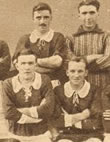 29 December: We have posted a few previously unrecorded Third Lanark strips today (1903-04, 1921-22, 1928-29, 1932-33, 1947-48, 1956-57, 1963-64). The photograph is of the 1921-22 team wearing comedy collars and comes from the rather good Third Lanark History website, from which much of this new information is sourced.
29 December: We have posted a few previously unrecorded Third Lanark strips today (1903-04, 1921-22, 1928-29, 1932-33, 1947-48, 1956-57, 1963-64). The photograph is of the 1921-22 team wearing comedy collars and comes from the rather good Third Lanark History website, from which much of this new information is sourced.
Thanks to research by Tony Sealey and John Mathews , the 1949-1955 entries on the Tottenham Hotspur Away Kit section have been slightly revised.
Peterborough United (1936-37 added). Replicas of Manchester City's 1989-90 shirt are now available.
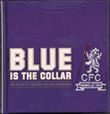 23 December: Do look out for Blue is the Collar, a lavishly illustrated and detailed guide to Chelsea kits and memories (Sport Media 2011 £9.99). As reported on 20 October, HFK has provided graphics.
23 December: Do look out for Blue is the Collar, a lavishly illustrated and detailed guide to Chelsea kits and memories (Sport Media 2011 £9.99). As reported on 20 October, HFK has provided graphics.
Current season updates: Wrexham (new shirt sponsor); Airdrie United (new 3rd strip).
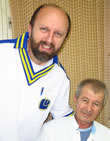 18 December: It's always good to hear from old friends as the festive season approaches. Regular visitors will recall the splendid Dr Stefan Stamirov of the Medical University of Pleven in northern Bulgaria who designs his own ward gowns based on famous football shirts. Here Stefan models his latest creation, based on Leeds United's 1976-77 shirt, while he looms - but in a good way - over a colleague.
18 December: It's always good to hear from old friends as the festive season approaches. Regular visitors will recall the splendid Dr Stefan Stamirov of the Medical University of Pleven in northern Bulgaria who designs his own ward gowns based on famous football shirts. Here Stefan models his latest creation, based on Leeds United's 1976-77 shirt, while he looms - but in a good way - over a colleague.
Updates: Heart of Midlothian (1971 change strip added to Iconic Away Kits section): Dumbarton (1988-89, 1993-95, 1995-96 detailing added): Bristol City (1957-58 added): Liverpool (1957-58 warm weather change kit added).
 Finally for today, Neil Le Milliere writes to tell us about the London Exeter Exiles, who recently got together wearing treasured replica shirts. This led to Neil identifying a missing item for our Exeter City section (1986-89 added). Neil also supplied this photograph of the 1993-94 top, modelled for us by two Exiles. Intact versions of this shirt are, apparently, rather rare as supporters tended to remove the sponsors logo because it was in the colours of their West Country rivals, Plymouth Argyle.
Finally for today, Neil Le Milliere writes to tell us about the London Exeter Exiles, who recently got together wearing treasured replica shirts. This led to Neil identifying a missing item for our Exeter City section (1986-89 added). Neil also supplied this photograph of the 1993-94 top, modelled for us by two Exiles. Intact versions of this shirt are, apparently, rather rare as supporters tended to remove the sponsors logo because it was in the colours of their West Country rivals, Plymouth Argyle.
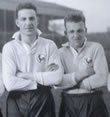 15 December: HFK Research Associate Tony Sealey is spending the long winter nights researching obscure Spurs strips for us. Among his finds is this photograph taken at The Hawthorns in 1930-31. I believe these show the cashmere tops worn at the time in unprecedented detail. While the main body of the shirt would have been made from finely woven wool, this would not have been sufficiently robust for the the collars and crest, which appear to be made from white cotton. The contrast between the off-white cashmere and true-white cotton is evident. (Tottenham Hotspur August 1945 change, 1958-62 third added.)
15 December: HFK Research Associate Tony Sealey is spending the long winter nights researching obscure Spurs strips for us. Among his finds is this photograph taken at The Hawthorns in 1930-31. I believe these show the cashmere tops worn at the time in unprecedented detail. While the main body of the shirt would have been made from finely woven wool, this would not have been sufficiently robust for the the collars and crest, which appear to be made from white cotton. The contrast between the off-white cashmere and true-white cotton is evident. (Tottenham Hotspur August 1945 change, 1958-62 third added.)
2011-12 updates: Millwall (3rd), Walsall (3rd), Airdrie United (new sponsor/recycled shirt).
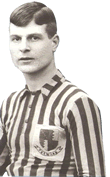 14 December: It is now clear that the replacement Plymouth Argyle strips due to be delivered in September have been cancelled by the new owners and these graphics have been removed.
14 December: It is now clear that the replacement Plymouth Argyle strips due to be delivered in September have been cancelled by the new owners and these graphics have been removed.
This photograph from 1886 shows Dennis Hodgetts wearing the chocolate and blue shirts worn by Aston Villa at the time. Lee Gauntlett has identified the crest as being the Birmingham coat of arms from that period.
Newcastle United (1930-31 added; 1966-67 & 1967-69 change added); Darlington (1921-36 updated); Wolves (1947-48 added).
13 December: Apologies for the lack of activity over the past three weeks. This was due to a temporary loss of our broadband connection during a major hardware upgrade. After years of software conflicts and hardware failures, we have scrapped our steam-driven PC and content will now be brought to you minty-fresh from a brand-new Mac via, thanks to the Welsh Assembly Government, satellite link.
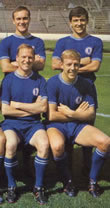 21 November: We have known for some time that in the summer of 1962, Tommy Docherty proposed introducing an all-blue strip at Chelsea but was over-ruled by the board who thought the new look too radical. Terry Morley has discovered this photograph of the team wearing the Doc's revolutionary outfit. It fell to Jimmy Hill's Coventry City to introduce the first set of matching shirts and shorts as part of his Sky Blue Revolution of 1962-63. Docherty got his way at the start of the 1964-65 season when the iconic all-blue strip with white socks first appeared.
21 November: We have known for some time that in the summer of 1962, Tommy Docherty proposed introducing an all-blue strip at Chelsea but was over-ruled by the board who thought the new look too radical. Terry Morley has discovered this photograph of the team wearing the Doc's revolutionary outfit. It fell to Jimmy Hill's Coventry City to introduce the first set of matching shirts and shorts as part of his Sky Blue Revolution of 1962-63. Docherty got his way at the start of the 1964-65 season when the iconic all-blue strip with white socks first appeared.
There had, of course, been examples of teams wearing matching white shirts and shorts going back to Victorian times but it was not until nylon shorts in a range of colours became available in the late-Fifties that the now familiar one-colour strip became possible.
Other updates: Ipswich Town (current 3rd added), Hartlepool United (current 3rd added), Huddersfield Town (2011 charity kit updated): Southend United (2010-11 socks corrected): Aston Villa (1988-89 socks corrected).
11 November: The Hull City section has been revised with new crests (1947 & 1957), embossing details (1982-1997) and colour adjustments. AFC Bournemouth (crest 1936-74 revised).
2 November: Liverpool (1957-58 change kit added): Everton (2000-01 third shirt detail added): Aston Villa (1982-83 European Cup strip added): Hull City (2011-12 away kit updated).
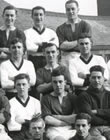 1 November: Pictured on the left is the Barnsley side from 1927-28. The worn-looking red tops are typical of the period but the smart, probably brand new white change shirts are adorned with V necks. Although this design became commonplace in the late-Fifties, it first appeared in the Twenties but failed to catch on.
1 November: Pictured on the left is the Barnsley side from 1927-28. The worn-looking red tops are typical of the period but the smart, probably brand new white change shirts are adorned with V necks. Although this design became commonplace in the late-Fifties, it first appeared in the Twenties but failed to catch on.
Manchester United (2011-12 European home kit added; 2007-08 third added; 2007-08, 2008-09 third kits amended): Arsenal (2006-07 third added): Ashington (1923-24 sock detail added): Birmingham (1919-22 socks confirmed): Blackburn Rovers (1923-24 amended): Blackpool (1951 FA Cup final crest amended): Bolton Wanderers (1953 FA Cup final crest added).
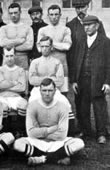 20 October: It is well established that Chelsea's first colours were taken from the Earl of Cadogan's racing colours but precisely what shade of blue these were has, until now, been unclear. Enquiries by HFK have revealed that this was in fact Eton Blue, an unusual shade of light, greenish blue worn by the famous Old Etonians club in the 19th century. As far as we know, this is the only instance of these colours appearing in the Football League. The photograph was taken on 1 August 1905 before the team had kicked a ball and shows their brand new strip to good effect.
20 October: It is well established that Chelsea's first colours were taken from the Earl of Cadogan's racing colours but precisely what shade of blue these were has, until now, been unclear. Enquiries by HFK have revealed that this was in fact Eton Blue, an unusual shade of light, greenish blue worn by the famous Old Etonians club in the 19th century. As far as we know, this is the only instance of these colours appearing in the Football League. The photograph was taken on 1 August 1905 before the team had kicked a ball and shows their brand new strip to good effect.
Some changes have been made to the Chelsea Away Kit section thanks to input from Nik Yeomans who is helping in the production of a new history of Chelsea kits from 1960 to the present, "Blue is the Collar." HFK is proud to have provided the graphics for the book and we will let you know when it is due to be published.
In a similar vein, a note from Bruce Wright provides strong evidence that Queen of the South wore their familar royal blue shirts for the first time in May 1922, implying that the tops worn earlier (and shown in the photograph published on 12 October) were in fact the lighter blue inherited from the 5th King's Own Scottish Borderers, one of the clubs that amalgamated to form QoS in 1919.
We have finally been able to confirm shirt sponsorship for East Stirlingshire's current away strip. Other updates for 2011-12 include Brentford (A updated), Huddersfield Town (charity strip) and West Ham United (3rd).
Other updates: Crest histories revised for Bradford (Park Avenue) and Bradford City: Everton (1985-86 3rd, 1988-90 3rd added, 1992-93 crest corrected).
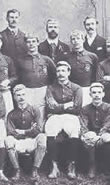 12 October: Our commiserations go to Scottish fans whose team last night failed to pull off the impossible in Spain and were eliminated from Euro 2012. The strip worn in that game and their attractive new
12 October: Our commiserations go to Scottish fans whose team last night failed to pull off the impossible in Spain and were eliminated from Euro 2012. The strip worn in that game and their attractive new 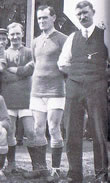 home strip have been posted in the Scotland 2010-19 section. The photograph on the left is of the Scottish team that played the first ever international against England in 1872.
home strip have been posted in the Scotland 2010-19 section. The photograph on the left is of the Scottish team that played the first ever international against England in 1872.
Still on a Scottish theme, I recently came across this photograph (right) of the first ever Queen of the South team from 16 August 1919, which neatly fills a gap in our records. This and other historical team groups can be found on the excellent history section of the club's official website.
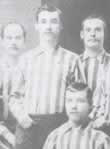 11 October: Special signed editions of The Worst Football Kits of All Time are now available in the HFK Shop.
11 October: Special signed editions of The Worst Football Kits of All Time are now available in the HFK Shop.
Neil Capewell has sent us a cutting from a contemporary newspaper report that pins down the exact date that Wolverhampton Wanderers switched from blue and white to red and white striped shirts. Furthermore, this means that the striped tops worn by the team in 1883-84 and shown here, must have been blue and white.
The latest twists in the sorry tale at Plymouth Argyle have been added to the club page while the West Ham United section has been updated with an unrecorded crest from 1958 and today's developments in the Olympic Stadium saga.
Several clubs with half an eye on the Christmas market are launching new third strips. Added to HFK today are Cardiff City, and Hibernian.
I am indebted to Ed Dursley who has provided a wealth of information that has allowed me to amend the detailing on the Kidderminster Harrier kits 1985-1998 and add several missing strips. In the course of researching the club's crest history I came across details of several early strips (1886-1928) and these have also been added along with the missing badges.
30 September: Tottenham Hotspur (1903-04, 1925-26 change kits added): Chesterfield (new third strip added): Brechin City (1978-79 manufacturer's details added).
 Friend of HFK and part-time alchemist George Chilvers has been at it again, casting his spell over a battered photograph of Liverpool Ramblers dating from 1882-83 to produce this astonishing colourised image. George's work will feature in Jonathon Russell's forthcoming official history of the club. The Ramblers competed in the FA Cup in their first three seasons but since then have stuck to the strictest of amateur principles by playing only friendly matches against club and school sides. Jonathon believes they are the oldest club in the world never to have played in a league of any kind and would like to know if any of HFK's "wise and learned readers" (his words not mine) can corroborate this. Meanwhile the Ramblers have taken a well-deserved place in our Eminent Victorians section.
Friend of HFK and part-time alchemist George Chilvers has been at it again, casting his spell over a battered photograph of Liverpool Ramblers dating from 1882-83 to produce this astonishing colourised image. George's work will feature in Jonathon Russell's forthcoming official history of the club. The Ramblers competed in the FA Cup in their first three seasons but since then have stuck to the strictest of amateur principles by playing only friendly matches against club and school sides. Jonathon believes they are the oldest club in the world never to have played in a league of any kind and would like to know if any of HFK's "wise and learned readers" (his words not mine) can corroborate this. Meanwhile the Ramblers have taken a well-deserved place in our Eminent Victorians section.
22 September 2011-12 updates: Queens Park Rangers (sponsorship added), Stoke City (3rd added), Luton Town (detailing added), Bradford City (3rd updated), Gillingham (3rd socks amended), AFC Bournemouth (3rd added).
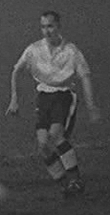 Cambridge United (2009-10 socks corrected): Rushden & Diamonds (1994-95 manufacturer details added): Queens Park Rangers (1926-30 collar amended).
Cambridge United (2009-10 socks corrected): Rushden & Diamonds (1994-95 manufacturer details added): Queens Park Rangers (1926-30 collar amended).
The intriguing story of the crest commissioned in 2003 but never used has been researched by Joshua Malpass and now appears in the Wimbledon FC section.
Steve Gordos has discovered that the fluorescent yellow shirts sported by Wolverhampton Wanderers in floodlit friendlies in the Fifties (shown left) made their first appearance in 1951, two years before floodlights were installed at Molyneux.
Visitors interested in American Football will enjoy the Gridiron Uniform Database, a highly detailed archive going back to 1933.
7 September: Stirling Albion (1996-98 detailing added): Crystal Palace (crest history revised).
Room 101 has been upgraded and has several new additions. Three nasties have been added to the Iconic Away Kits section Kilmarnock (1992), Ipswich Town (1996) and Dundee United (1993).
5 September 2011-12 updates: Portsmouth (2011-12 3rd), Northampton Town (2011-12 A updated), Charlton Athletic (A shorts/socks confirmed), Colchester United (A socks confirmed), Exeter City (A* added), Elgin City (sponsorship added).
2 September 2011-12 updates: Hartlepool United (A added), Dumbarton (sponsorship added).
More on the Plymouth strip featured below. John Taylor has found a photograph of Argyle's youth team wearing the banded shirt.
Jonathon Russell has found a press cutting from October 1881 that sheds new light on the famous black and scarlet Everton strip.
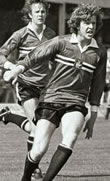 25 August 2011-12 updates: Queens Park Rangers (A socks modified), Liverpool (trim added to A shorts), Tranmere Rovers (detail added to H), Ipswich Town (A* added), Leicester City 3rd* added).
25 August 2011-12 updates: Queens Park Rangers (A socks modified), Liverpool (trim added to A shorts), Tranmere Rovers (detail added to H), Ipswich Town (A* added), Leicester City 3rd* added).
This interesting strip, worn by Gary Megson, was worn by Plymouth Argyle at Chesterfield on 19 August 1978 and was spotted by John Taylor. Trevor Scallon, an expert on Argyle history, writes, It appears to be a precursor of an away kit that was used very rarely, when the regular home kit was a little too similar to the opposition, as it appears to be in the Chesterfield picture. The bigger version of the Megson picture certainly confirms it was also made by Bukta, so I guess they just knocked it up for occasional 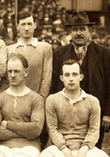 use. The photo is from the excellent Greens on Screen Database.
use. The photo is from the excellent Greens on Screen Database.
Everton adopted plain royal blue shirts in 1901 and it was not until 1956 that these were adorned with white trimmings. Willie Kay, however, has found this intriguing team photograph from 13 September, 1919 that shows clearly shirts with white collars. Despite being taken at the start of the season, the shirts look very badly faded and worn, suggesting that they are an old set, held over because of war time shortages.
Tranmere Rovers (1987-91, 1995-97 shadow print added): Southampton (1899-1900 added).
20 August: Darrin Foss' research has established that the white shirts worn with unusual dark brown knickerbockers sported by Notts County in 1889-90 were almost certainly a change strip. The outfit was worn against Aston Villa and Blackburn Rovers but in other matches, contemporary press reports describe 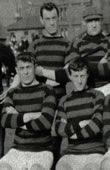 them as continuing to wear chocolate and blue. The strip has been moved to the Iconic Change Kits section.
them as continuing to wear chocolate and blue. The strip has been moved to the Iconic Change Kits section.
This fine photograph is one of several rare vintage team groups on the Partick Thistle History Archive. This particular image is from 1907-08 when Thistle wore claret and blue jerseys.
Norwich City (1972-73 added): Berwick Rangers (1992-94 added; crest history updated): Burton Albion (1981-83 added).
19 August: The Rushden & Diamonds section has been updated after the club was wound up last month.
2011-12 updates: Motherwell (A corrected), Sheffield United (H & A socks updated), Northampton Town (3rd added), Bradford City (3rd added), Peterborough United (3rd added).
Crawley Town (1989-90, 1996-97, 2000-01 added; 1990-91 sponsor added): Tottenham Hotspur (1920-21 added): Maidstone United (1985-86 added).
14 August 2011-12 additions: Wrexham (H), Doncaster Rovers (H shorts/socks changed, A added), Brentford (A shorts corrected), Kidderminster Harriers (H), Hereford United (H socks updated).
11 August 2011-12 additions: Wales (H), Republic of Ireland (H), Rangers (3rd socks amended), Arsenal (H, 3rd updated), Blackburn Rovers (sponsorship updated), Gillingham (socks confirmed), Accrington Stanley (A), AFC Wimbledon (special kit updated), Burton Albion (A), Rochdale (3rd), Coventry City (A*), Exeter City (socks corrected), Stockport County (sponsorship added), Exeter City (3rd), Morecambe (A shorts/socks confirmed).
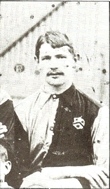 Historical updates: Pictured here is Dan Doyle of Grimsby Town, taken sometime in 1888-89. Of interest is the Grimsby coat of arms worn on his shirt. Doyle was involved in a collision with William Cropper of Staveley on 12 January. Cropper had to leave the pitch and died that night of abdominal injuries. (Photo and story contributed by Warren Lyons.)
Historical updates: Pictured here is Dan Doyle of Grimsby Town, taken sometime in 1888-89. Of interest is the Grimsby coat of arms worn on his shirt. Doyle was involved in a collision with William Cropper of Staveley on 12 January. Cropper had to leave the pitch and died that night of abdominal injuries. (Photo and story contributed by Warren Lyons.)
Bradford Park Avenue (some tidying up of early Sixties): Gillingham (1983-84 added): Tranmere Rovers (early history updated): Peterborough United (1956-60 added): Everton (1932 change kit shirt trim amended).
6 August: The new EPL handbook has now been published (thanks to everyone who sent in links) and as a result we have been able to complete the 2011-12 English Premier League section.
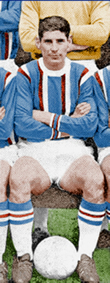 5 August: On reading that Gio Alzapiedi had never seen a colour photograph of the candy striped Aberdeen kit, George Chilvers rides to the rescue. George colourises old monochrome photos and he has sent us the fruits of his latest labour. You can also now find it on our Iconic Away Kits gallery.
5 August: On reading that Gio Alzapiedi had never seen a colour photograph of the candy striped Aberdeen kit, George Chilvers rides to the rescue. George colourises old monochrome photos and he has sent us the fruits of his latest labour. You can also now find it on our Iconic Away Kits gallery.
2011-12 additions: Plymouth Argyle (temporary kit shorts/socks confirmed), Cheltenham Town (H, A*), Tranmere Rovers (H), Wigan Athletic (H socks confirmed), Lincoln City (H - very nasty this one).
4 August 2011-12 additions: Partick Thistle (A corrected), Birmingham City (sponsorship added), Northampton Town (missing details confirmed), Oxford United (A).
3 August 2011-12 additions: AFC Bournemouth (A), Barnet (H, A), Rangers (3rd).
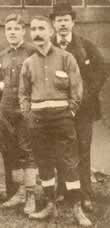 2 August: Pictured here are the players and officials of Partick Thistle from 1888-89 wearing an all-navy strip, very typical of Scottish teams of the period. The picture comes from the collection at The Partick Thistle History Archive.
2 August: Pictured here are the players and officials of Partick Thistle from 1888-89 wearing an all-navy strip, very typical of Scottish teams of the period. The picture comes from the collection at The Partick Thistle History Archive.
Millwall (1990-91 sponsorship removed), Celtic (1977-78 change kit added), Yeovil Town (1993-94, 1995-96 added), East Stirlingshire (1981 centenary kit added), Accrington Stanley (1995-96 manufacturer's details added).
We would like to thank Ian Hands for supplying details that have allowed us to add considerable to the new Crawley Town section. (1946, 1958-59, 1964-65, 1972-73, 1974-75, 1979-80, 1990-91, 2000-01, 2005-06 and some crests added).
1 August 2011-12 additions: Queen's Park (H shorts detailing added), Hamilton Academical (A, 3rd sponsorship confirmed), Aberdeen (A), Exeter City (H), Shrewsbury Town (H, A*, 3rd), Morecambe, (H, A), Torquay United (H, A*), Plymouth Argyle (H, A NB there are two sets of each - full story on the club page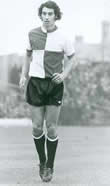 ), Barnsley (A).
), Barnsley (A).
Leaving the new Puma King template aside (see 17 July post below), the trend this season is for retro-influenced kits, a welcome development in our view here at HFK Towers. Here. for example, is the quartered shirt worn as a change strip by Queens Park Rangers in 1974-75 that has provided the inspiration for the team's new third kit. Note the early Umbro logos: manufacturers' trademarks started to appear on shirts the previous season.
Aside from a few sponsorship details, which are still under negotiation, the Scottish club section is now complete for 2011-12.
Ice Hockey (or just "Hockey" if you happen to be from Canada) has its own version of HFK at nhluniforms.com.
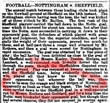 29 July: For the time being, HFK is of course focusing on posting the new club strips for the coming season but it's good to have a reminder that we are also concerned with the history of club colours going back to the dawn of the game. This cutting, found by Darrin Foss in the course of his research into the history of Notts County comes from the Nottinghamshire Guardian and is dated 22 February 1866. As well as offering a fascinating account of how the game was played under Sheffield Rules, it mentions that Notts wore "orange and black stripes," making this perhaps the earliest ever contemporary record of a team wearing uniform kit. (Click on the thumbnail to view a larger version.)
29 July: For the time being, HFK is of course focusing on posting the new club strips for the coming season but it's good to have a reminder that we are also concerned with the history of club colours going back to the dawn of the game. This cutting, found by Darrin Foss in the course of his research into the history of Notts County comes from the Nottinghamshire Guardian and is dated 22 February 1866. As well as offering a fascinating account of how the game was played under Sheffield Rules, it mentions that Notts wore "orange and black stripes," making this perhaps the earliest ever contemporary record of a team wearing uniform kit. (Click on the thumbnail to view a larger version.)
2011-12 additions: Queens Park Rangers (3rd), AFC Wimbledon (promotion special), Blackburn Rovers (A), Aldershot Town (H, A), Wigan Athletic (H).
27 July 2011-12 additions: Macclesfield Town (H), Hull City (A), Crewe Alexandra (A), Forfar Athletic (H, A), Elgin City (H, A), Peterhead (H, A), Montrose (H, A), Queen's Park (H, A), Stranraer (H*).
26 July 2011-12 additions: Blackburn Rovers (sponsorship added), Airdrie United (H*, A*), Arbroath (H, A), Partick Thistle (A), Hamilton Academical (H), Falkirk (A*), Queen of the South (A sponsor added), Greenock Morton (A, 3rd), Brechin City (H, A), Cowdenbeath (A), Dumbarton (H, A), Stenhousemuir (H, A), Stirling Albion (H, A), Clyde (Sponsorship added, 3rd), Berwick Rangers (3rd).
25 July 2011-12 additions: Motherwell (A), St Johnstone (A), Gillingham (shade of blue adjusted), Dagenham & Redbridge (H shorts/socks confirmed), Hereford United (H*, A), Southampton (A), Swindon Town (A), Watford (A), Bristol City (H), Bristol Rovers (H, A).
We have a bit more on the striped Aberdeen top featured on 17 July (below) from Gio Alzapiedi: This photo actually shows the Dons' CHANGE strip at the time which was usually referred to as the 'candystripe' kit. The broader, lighter stripes were blue and the narrower ones red and white. Unsurprisingly, it was pretty unpopular and colour images of it seem thin on the ground as a result, although if you can find one I'd love to see it. Despite this, Aberdeen were clearly too tight-fisted to throw it away, and I've seen photos of them wearing it against Hearts as early as 63/4, and a pal of mine claims it made an appearance as late as 1970 in a cup-tie against Clydebank.
22 July 2011-12 additions: Chesterfield (A), Notts County (strips amended), Leeds United (A), Port Vale (H*), Darlington (H), Brechin City (H*, A*), Kilmarnock (A*), East Fife (H, A, 3rd).
*Unchanged.
20 July 2011-12 additions: Albion Rovers (H, A), Kilmarnock (H), Sheffield Wednesday (H shorts/socks confirmed), Walsall (H, A), Blackpool (H, A), Aston Villa (H), Norwich City (A), Southampton (H), Leeds United (3rd), Derby County (A), Brighton & Hove Albion (H), Celtic (A).
The controversial new England away kit is now on view.
18 July: HFK Research Associate, Steve Turner, has given us the low down on the striped shirts worn by Aberdeen in 1965-66 and featured yesterday: I can confirm that this kit and indeed this line up was for a game versus Partick Thistle on 12th March 1966. The colours were Red, Blue and White and I can only assume that the lighter 'colour' is Red. Why they wore this kit for this match, I do not know, although again I can only assume it was due to a colour clash with Thistle's Yellow and Red?? I have no record of Aberdeen ever wearing this strip before or after.
2011-12 additions: Burton Albion (H), Bury (H, A).
17 July 2011-12 additions: Crawley Town (H, A, 3rd), Dagenham & Redbridge (H, A*), Bolton Wanderers (A), Blackburn Rovers (H socks confirmed),  Motherwell (125th anniversary).
Motherwell (125th anniversary).
*Unchanged.
German sportswear company Puma have made very significant advances in capturing the market in England and Scotland with new versions of their "King" template this season. The design originates with Johann Cruyff who, during the 1974 World Cup finals, modified his Adidas strip by removing one of the three trademark stripes because he was under personal contract to Puma (whose boots he wore). Puma have now taken this "two-stripe" theme to create their new range, which has the advantage of being highly flexible and instantly recognisable, much like the strips of their arch-rivals Adidas. (Photograph courtesy of football-shirts.co.uk).
Umbro, meanwhile, are producing some outstanding designs while their parent company, Nike, continue to supply well-designed, simple strips (with the notable exception of their jaggy stripes template, which we hope will be consigned to the dustbin in short order). Adidas, as usual, have created some interesting strips for 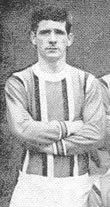 the big names they supply but lesser clubs have to settle for standard templates. The smaller suppliers continue to offer some interesting designs that provide refreshing relief from the templates of the big global sports wear players.
the big names they supply but lesser clubs have to settle for standard templates. The smaller suppliers continue to offer some interesting designs that provide refreshing relief from the templates of the big global sports wear players.
This intriguing photograph of Aberdeen FC from 1965-66, discovered by Terry Morley in a programme for a friendly against Crystal Palace, serves as a reminder of those days when commercial considerations did not enter into kit design. As far as we know, the Dons wore red shirts and white shorts that season so we would be keen to know if anyone can shed any light on this particular outfit. Get in touch if you can help.
15 July 2011-12 additions: Crystal Palace (A corrected), Stevenage (H, A, 3rd), Sheffield Wednesday (H added, sponsorship added), Sheffield United (sponsorship added), Manchester United (A), Swansea City (A), Birmingham City (3rd), Manchester City (H), Wycombe Wanderers (H, A),
13 July 2011-12 additions: Cardiff City (A), York City (H).
12 July 2011-12 additions: Newcastle United (A), Millwall (H, A), Sheffield United (A), Charlton Athletic (A), Crystal Palace (A), Middlesbrough (A), Queen of the South (H sponsorship added).
8 July 2011-12 additions: Partick Thistle (H), Dundee United (A).
7 July 2011-12 additions: East Stirlingshire (H, A), Clyde (H, A), St Johnstone (H), Dunfermline Athletic (H, A), Sheffield United (H), Reading (H, A), Leeds United (H), Oxford United (H).
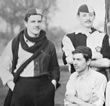 5 July: John Crawford has sent in this charming team photograph, thought to have been taken in the early 1880s, possibly in Goudhurst, Kent. Standing second from the left is the splendidly named Algernon Haskett-Smith, one of John's relatives, who graduated from Oxford University in 1879. We believe that Algernon and two other players are wearing Oxford University football shirts but the variety of other club shirts and caps on show suggest this was not a formal team. I speculate that these are a group of prominent young players who met in a local park for this photograph. If you recognise any of the players or can shed any light on the photo, please get in touch.
5 July: John Crawford has sent in this charming team photograph, thought to have been taken in the early 1880s, possibly in Goudhurst, Kent. Standing second from the left is the splendidly named Algernon Haskett-Smith, one of John's relatives, who graduated from Oxford University in 1879. We believe that Algernon and two other players are wearing Oxford University football shirts but the variety of other club shirts and caps on show suggest this was not a formal team. I speculate that these are a group of prominent young players who met in a local park for this photograph. If you recognise any of the players or can shed any light on the photo, please get in touch.
2011-12 additions: LA Galaxy (3rd), Everton (H), Brighton & Hove Albion (A), MK Dons (H, A, 3rd).
A new section for the 1891-92 Football League has been added to the season galleries. This was the first season that members registered their colours.
3 July 2011-12 additions: Gillingham (H, A, 3rd), Leicester City (A), Brentford (socks confirmed), Bradford City (H, A).
1 July 2011-12 additions: Peterborough United (H corrected - oops!), Birmingham City (H, A), Portsmouth (H), Raith Rovers (A), Ross County (H, A), Falkirk (H*), Huddersfield Town (A).
* unchanged.
30 June 2011-12 additions: West Bromwich Albion (H, A), Peterborough United (H), Fulham (H), Aberdeen (H), Luton Town (H), Scunthorpe United (H), Berwick Rangers (H, A).
28 June: Crest histories added to Annan Athletic, Arbroath (1995-97, 1997-98, 1998-99 amended), Berwick Rangers (1994-95, 1995-96 amended), Brechin City (1996-97 amended), Clyde, Clydebank.
20011-12 additions: Arsenal (A), Hibernian (A), Brighton (Special), Alloa Athletic (H*, A, 3rd*), AFC Bournemouth (H).
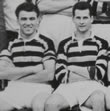 25 June: Featured here is Alloa from 1956-57, showing several players wearing hooped socks from the previous season. Alloa are one of many Scottish clubs to have worn hooped tops for much of their history. Quite why hoops remained popular in Scotland long after they fell out of favour elsewhere is one of life's little mysteries. Alloa switched to plain shirts in 1972 to save money but for most of the last decade, the team have been turning out in modern versions of their traditional outfit.
25 June: Featured here is Alloa from 1956-57, showing several players wearing hooped socks from the previous season. Alloa are one of many Scottish clubs to have worn hooped tops for much of their history. Quite why hoops remained popular in Scotland long after they fell out of favour elsewhere is one of life's little mysteries. Alloa switched to plain shirts in 1972 to save money but for most of the last decade, the team have been turning out in modern versions of their traditional outfit.
Ayr United (1938-40, 1945-48 amended; crest history added): Millwall (1936-37 added): Aberdeen (1986-87, 1987-90 jacqard texture added; crest history added): Crest histories have been added to the Airdrie United, Airdrieonians & Albion Rovers sections.
2011-12 additions: Motherwell (H), Inverness Caledonian Thistle (A).
24 June 2011-12 additions: Portsmouth (A), Aston Villa (A), Burnley (A), Raith Rovers (H), Rangers (A), Ayr United (H, A).
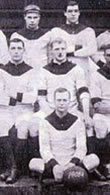 22 June: Scotland (1961-62, 1965-66 added): Barnsley (1923-24 added; 1994-95 amended and the story behind the change added to the text): Bristol City (1924-25 added): Third Lanark (1946-50, 1950-56 cuffs altered): Rochdale (1957-58 added).
22 June: Scotland (1961-62, 1965-66 added): Barnsley (1923-24 added; 1994-95 amended and the story behind the change added to the text): Bristol City (1924-25 added): Third Lanark (1946-50, 1950-56 cuffs altered): Rochdale (1957-58 added).
The decision by Liverpool to include light blue (sorry, "cyan") in their new third kit has provoked a furious controversy on Merseyside. Adidas' have pointed out the colour is a reference to the club's earliest colours worn between 1892 and 1896 but this has not mollified fans who refuse to have anything to do with the colour blue. Perhaps they might have done better to look back to this splendid red and white change kit from 1905-06, a championship season and the first example I have come across of a yoked shirt.
21 June 2011-12 additions: Carlisle United (A socks updated), Tranmere Rovers (H*, A*), Southend United (H), Livingston (A corrected), Tottenham Hotspur (H, Cup, A, 3rd), West Ham United (H, A).
18 June 2011-12 additions: Cardiff City (H), Brentford (H), Nottingham Forest (A), Grimsby Town (H), Swansea City (H).
 Some time ago HFK was commissioned to produce a history of Rangers' kits by the club. The finished poster is on display in the Trophy Room at Ibrox where it was spotted by Robert Bruce, who sent us this snap.
Some time ago HFK was commissioned to produce a history of Rangers' kits by the club. The finished poster is on display in the Trophy Room at Ibrox where it was spotted by Robert Bruce, who sent us this snap.
I am grateful to Tony Sealey whose latest research on behalf of HFK has revealed that between 1969 and 1977, Arsenal had two versions of their yellow and blue change kit. The long sleeved shirts had plain yellow crew necks while the short sleeved sets were trimmed in blue.
Other Historical Updates: Millwall (1955-56 added): Lincoln City (May 2001 added): St Mirren (1972-73, 1989-91, 1998-99, 2005-06 amended): Hereford United (1988-89 added).
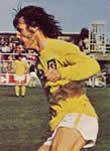 17 June: Celtic (1976-77 change kit added; 1982-83 away & third, 1983-86 away corrected): Tottenham Hotspur (1889-90 added; 1995-97 short sleeved variant added): Wales (kit worn v Luxembourg May 1975 added - see photo).
17 June: Celtic (1976-77 change kit added; 1982-83 away & third, 1983-86 away corrected): Tottenham Hotspur (1889-90 added; 1995-97 short sleeved variant added): Wales (kit worn v Luxembourg May 1975 added - see photo).
16 June 2011-12 additions: Liverpool (3rd), Barnsley (H), Brentford (A), Colchester United (A), Doncaster Rovers (H).
13 June 2011-12 additions: Chelsea (A), Port Vale (A fixed), Yeovil Town (A*), Celtic (H*).
*Unchanged.
9 June 2011-12 additions: Manchester United (H sock trim fixed), Mansfield Town (H), Norwich City (H), Hull City (H), Stockport County (H & crest).
Maidstone United (makers logos added to 1982-84, 1986-87, 1987-88 graphics): Crawley Town (1971-72 added; 1958-61 socks corrected): Brentford (1969-70 corrected): West Ham United (1973-74 added).
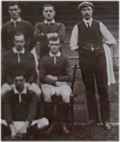 3 June 2011-12 additions: Chesterfield (H detailing added), Sheffield Wednesday (A detailing added), Port Vale (A), Colchester United (H*), AFC Wimbledon (A*, 3rd), Newcastle United (3rd), Dundee United (H), Heart of Midlothian (H), Derby County (H), Nottingham Forest (H), Republic of Ireland (A), Wales (A), Scotland (A).
3 June 2011-12 additions: Chesterfield (H detailing added), Sheffield Wednesday (A detailing added), Port Vale (A), Colchester United (H*), AFC Wimbledon (A*, 3rd), Newcastle United (3rd), Dundee United (H), Heart of Midlothian (H), Derby County (H), Nottingham Forest (H), Republic of Ireland (A), Wales (A), Scotland (A).
*unchanged
AFC Wimbledon (2002 pre-season kit added): Chesterfield (sponsor's logo modified 2009-12).
The photograph is of Nottingham Forest in 1908-09 wearing collars that are remarkably similar to those on their new Umbro shirts.
1 June 2010-11 additions: Preston North End (A), Wolverhampton Wanderers A*), Southend United (A), Northampton Town (H, A), Charlton Athletic (H*, 3rd*), Sheffield Wednesday (A), Stoke City (A), Forfar Athletic (H), Stranraer (A), Greenock Morton (H), Annan Athletic (H, A).
*unchanged.
31 May: The English and Scottish season galleries for 2011-12 are now open. As usual we invite all our contributors to let us know about new strips as they are released. Mind your head as you enter the new galleries and please place your litter in the receptacles provided.
 29 May: Here is a fine photograph of Bradford City from 1937-38 that sheds light on one of the seasons that are currently missing from our records. City's claret and amber colours are unique in the Football League and they have a long track record of wearing distinctive strips so it is particularly pleasing to add another, previously unrecorded version to the archive.
29 May: Here is a fine photograph of Bradford City from 1937-38 that sheds light on one of the seasons that are currently missing from our records. City's claret and amber colours are unique in the Football League and they have a long track record of wearing distinctive strips so it is particularly pleasing to add another, previously unrecorded version to the archive.
Scottish team, Motherwell, of course share City's claret and amber colours and on at least two occasions the teams have worn identical shirts. In 1913 'Well adopted Bradford's iconic yoked tops while in 1983 the Yorkshire side, who were facing a severe financial crisis, turned out in a Patrick strip designed for Motherwell. Thanks to Keith Ellis we have been able to add several unrecorded strips (1938-39, 1948-49, 1960-61, 1961-62) and correct detailing on several more graphics.
AFC Bournemouth (1990-92 manufacturer's logo added).
2011-12 additions: Preston North End (H).
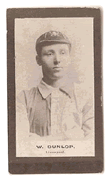 27 May 2011-12 additions: Celtic (3rd), Everton (A), Rotherham United (H), Wales (A).
27 May 2011-12 additions: Celtic (3rd), Everton (A), Rotherham United (H), Wales (A).
Shane Malia spotted this card for sale on eBay recently. The 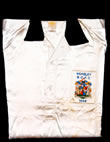 player is Billy Dunlop who joined Liverpool in 1895 and is wearing one of the blue and white shirts that were inherited (Liverpool fans should look away now) from Everton.
player is Billy Dunlop who joined Liverpool in 1895 and is wearing one of the blue and white shirts that were inherited (Liverpool fans should look away now) from Everton.
Our second feature is Birmingham City's splendid shirt from the 1956 FA Cup final, made from "silk" (ie rayon) and cream in colour.
Brentford (1949-50 added): Chelsea (1924-25, 1929-30 change kits added): AFC Bournemouth (1932-36 detailing amended): Bristol City (more accurate rendering of 1951-61 crest added): Bradford (Park Avenue) (1911-13 collar & socks amended): Millwall (1958-59 added - last hurrah for shiny rayon): Southampton (1903-04 added).
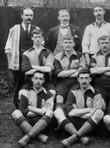 25 May: Sections for Crawley Town and AFC Wimbledon have been added to the site following their promotion to the Football League.
25 May: Sections for Crawley Town and AFC Wimbledon have been added to the site following their promotion to the Football League.
Wycombe Wanderers (1901-06, 1937-46, 1964-65 added). The Chairboys team of 1898-99 is shown here in shirts that are identical to those worn by QPR a decade earlier and featured yesterday, illustrating how little designs changed over time when compared to the modern era.
2011-12 additions: Notts County (H), Stoke City (H).
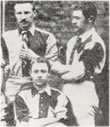 24 May: Featured here is Queen's Park Rangers from 1886-87, the first season that they played under that name. The shirts are Oxford and Cambridge blue and are a good example of what the Victorians called "quartered" shirts. (1899-1900, 1900-01, 1958-59 added; 1886-1892 corrected).
24 May: Featured here is Queen's Park Rangers from 1886-87, the first season that they played under that name. The shirts are Oxford and Cambridge blue and are a good example of what the Victorians called "quartered" shirts. (1899-1900, 1900-01, 1958-59 added; 1886-1892 corrected).
Wimbledon (1947-48 added): Everton (1889-90 pocket added to shirt).
23 May 2011-12 additions: Manchester United (H), St Mirren (H).
20 May: York City (2002-03 crest added and kit amended): Grimsby Town (1939-40 added; 1946-47 amended): Derby County (1932-33 added; 1893-94 collar details altered): Lincoln City (1909-10, 1911-12, 1924-25, 1926-27 added): Leeds United (1920-23 socks changed, 1949-53 crest altered): Glossop (1910-14 added).
2011-12 additions: Wolverhampton Wanderers (H), Hibernian (H).
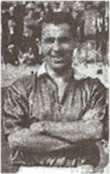 16 May: 2011 FA Cup final details added, Bristol City (2011 special home kit added, 1978-81 shorts corrected): Meadowbank Thistle (1988-90, 1991-92 added; 1985-86, 1986-87, 1990-91, 1992-93, 1993-95 amended): Rangers (1997-99 detailing added): Rochdale (1973-74 shorts corrected.
16 May: 2011 FA Cup final details added, Bristol City (2011 special home kit added, 1978-81 shorts corrected): Meadowbank Thistle (1988-90, 1991-92 added; 1985-86, 1986-87, 1990-91, 1992-93, 1993-95 amended): Rangers (1997-99 detailing added): Rochdale (1973-74 shorts corrected.
On the left is a photograph of the Rochdale team of 1955-56, wearing the shiny shirts that were briefly popular in the Fifties. Often described, fancifully, as "silk," these were in fact made of rayon and were the first football kits made from artificial fabric. They were first seen in the 1953 FA Cup final worn by Bolton Wanderers.
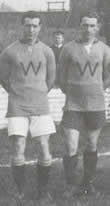 I have revised the graphics for Wimbledon from 1919-20 (see photo left) and 1920-21. Although we have no direct evidence of the colour of the shirts worn at this time, I now think they are likely to have green/black, consistent with earlier records of their colours. We do know that the club adopted blue and white in 1923 but are still seeking confirmation of their colours immediately after the Great War.
I have revised the graphics for Wimbledon from 1919-20 (see photo left) and 1920-21. Although we have no direct evidence of the colour of the shirts worn at this time, I now think they are likely to have green/black, consistent with earlier records of their colours. We do know that the club adopted blue and white in 1923 but are still seeking confirmation of their colours immediately after the Great War.
Crest histories have been added to the Wrexham, Wimbledon, Yeovil Town and York City sections. This completes our long-term project to add crest histories to the Football League/English Premier League club sections (although, as with anything on HFK, we welcome corrections and additions). As time and resources allow, crests histories will be added to the Scottish section over the coming months.
Our Room 101 section is currently featured in the Guardian Online Football Section's Favourite Things.
2011-12 additions: Bolton Wanderers (H), Leyton Orient (H).
10 May 2011-12 additions: Northern Ireland (A), Oldham Athletic (crest), Carlisle United (H), Crystal Palace (H).
8 May 2011-12 additions: Cowdenbeath (H), Leicester City (H), Middlesbrough (H), Huddersfield Town (H).
 Lee Gauntlet has sent in this cutting from The Birmingham Post dated September 1889 that illustrates the confusion that sometimes occured in the early years of the Football League. Aston Villa anticipated that Notts County would wear their usual chocolate and blue shirts and so ran onto the field in white only to discover that County had adopted white shirts (with splendid chocolate coloured knickers). A similar incident at Sunderland almost exactly a year later when Wolves turned up in a strip almost identical to that of the home team. At the League AGM in 1891 it was agreed that clubs
Lee Gauntlet has sent in this cutting from The Birmingham Post dated September 1889 that illustrates the confusion that sometimes occured in the early years of the Football League. Aston Villa anticipated that Notts County would wear their usual chocolate and blue shirts and so ran onto the field in white only to discover that County had adopted white shirts (with splendid chocolate coloured knickers). A similar incident at Sunderland almost exactly a year later when Wolves turned up in a strip almost identical to that of the home team. At the League AGM in 1891 it was agreed that clubs 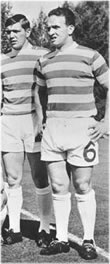 would in future register their colours and home sides would keep a spare set of white shirts to be used in the event of a clash.
would in future register their colours and home sides would keep a spare set of white shirts to be used in the event of a clash.
An e-mail from James Watt prompted me to look out this photograph of the 1966-67 Lisbon Lions side. Numbers were introduced in the Scottish Football League after the Second World war but were not compulsory until 1960. Due to the somewhat eccentric views of their chairman, Bob Kelly, Celtic placed their team numbers on the front and back of their shorts rather than on the back of their shirts.
In 1995 the Scottish Football League, demonstrating a typical preoccupation with the trivial, ruled that numbers would have to be worn on shirts. Celtic's response was to move the numbers to the top of their sleeves. (see new graphic on the Celtic page.) The gentlemen at the SFL were not amused and instructed the club to place them on the back of their shirts.
5 May 2010-11 additions: Burnley (H), Newcastle United (H), Aston Villa (H), Ipswich Town (H), NY Red Bulls (A).
Crest history added: Watford, West Ham United.
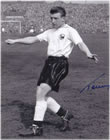 3 May: On the left is Terry Dyson of Tottenham Hotspur warming up at Old Trafford in April 1957. He is wearing the new style of short sleeved shirt with collars introduced at the beginning of the season but for some curious reason, the crest is in the old style dropped in 1951. Tony Sealey provided this item and has also identified exactly when Spurs switched from their "continental" V necks shirts with short sleeves to crew necks and long sleeves. Meanwhile Andy Porter has confirmed that the striped shirts worn by Spurs against Preston in the 1922 FA Cup semi-final were blue/white (not red/white as we had previously thought). The two teams had met in the 1921 semi as well and on this occasion Spurs wore red shirts, Preston navy blue. (Details now posted in the Tottenham Hotspur Away Kit Section.)
3 May: On the left is Terry Dyson of Tottenham Hotspur warming up at Old Trafford in April 1957. He is wearing the new style of short sleeved shirt with collars introduced at the beginning of the season but for some curious reason, the crest is in the old style dropped in 1951. Tony Sealey provided this item and has also identified exactly when Spurs switched from their "continental" V necks shirts with short sleeves to crew necks and long sleeves. Meanwhile Andy Porter has confirmed that the striped shirts worn by Spurs against Preston in the 1922 FA Cup semi-final were blue/white (not red/white as we had previously thought). The two teams had met in the 1921 semi as well and on this occasion Spurs wore red shirts, Preston navy blue. (Details now posted in the Tottenham Hotspur Away Kit Section.)
Workington (1966-67 crest added; 1956-57, 1975-76 detailing amended): Tranmere Rovers (crest history added): Walsall (crest history added).
2011-12 additions: Arsenal (H).
2 May 2011-12 additions: Chelsea (H), Liverpool (A), Crewe Alexandra (H), Rochdale (H), Coventry City (H), Swindon Town (H), Chesterfield (H), Dundee (H), Watford (H), Livingston (H).
Crest histories have been added to the Swindon Town & Torquay United sections.
29 April: Crests histories added to Southend United, Southport, Stockport County, Stoke City and Swansea City sections.
26 April: Help wanted! We shall shortly be adding a section for Crawley Town to HFK following their promotion to the Football League and urgently need information about the club's kit history.
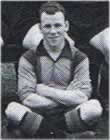 I am grateful to Ralph Pomeroy for filling in several gaps in our records for Bradford (Park Avenue). Of particular interest is this photograph of the 1933-34 team, taken from All About Avenue (Tim Clapham & Malcolm Lloyd Hartley 2004) which has allowed us to finally confirm the details of these unique shirts. (1931-34, 1946-47, 1957-58, 1958-59, 1959-60, Jan-May 1960, 1965-66 added.)
I am grateful to Ralph Pomeroy for filling in several gaps in our records for Bradford (Park Avenue). Of particular interest is this photograph of the 1933-34 team, taken from All About Avenue (Tim Clapham & Malcolm Lloyd Hartley 2004) which has allowed us to finally confirm the details of these unique shirts. (1931-34, 1946-47, 1957-58, 1958-59, 1959-60, Jan-May 1960, 1965-66 added.)
2010-11 additions: Rangers (H), Queen of the South (H).
24 April: Reading (crest history added): Sheffield United (1938-39 added; crest history added): Scotland (1905-09 colour of crest corrected): Republic of Ireland (1946-57 accurate crest applied).
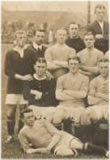 20 April: This interesting photograph is of the Chelsea squad and staff from 1911-12. At the time the team were still playing in the Earl of Cadogan's pale blue racing colours. Clearly there were not enough to go round so some players are wearing what I assume are dark red change shirts.
20 April: This interesting photograph is of the Chelsea squad and staff from 1911-12. At the time the team were still playing in the Earl of Cadogan's pale blue racing colours. Clearly there were not enough to go round so some players are wearing what I assume are dark red change shirts.
Maidstone United (1983-84, 1989-91, 1990-91 revised): West Bromwich Albion (1920-25, 1955-56 amended slightly): Birmingham City (1970-71 crest amended; crest history expanded): Stoke City (1961-63 cold weather kit added): Burnley (1947 FA Cup final strip corrected): Tottenham Hotspur (borrowed strip worn against Preston NE in the 1922 FA Cup semi-final added): Hull City (2006-07 revised): Workington (1950-51, 1951-52 added).
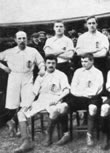 Thanks to Glen Isherwood and Keith Ellis, a wealth of detail has been added to the England kit history section as well as several previously unrecorded strips from the 1960s and 1970s. Featured here is the English team from 1897 wearing a variety of knickers and socks. At this time the FA supplied the flannel shirts but the players provided everything else. It was not until around the turn of the century that the FA specified that navy knickers should be worn and players continued to provide their own knickers and socks until the mid-1930s.
Thanks to Glen Isherwood and Keith Ellis, a wealth of detail has been added to the England kit history section as well as several previously unrecorded strips from the 1960s and 1970s. Featured here is the English team from 1897 wearing a variety of knickers and socks. At this time the FA supplied the flannel shirts but the players provided everything else. It was not until around the turn of the century that the FA specified that navy knickers should be worn and players continued to provide their own knickers and socks until the mid-1930s.
2010-11 additions: Wycombe Wanderers (third kit): Leyton Orient ( third kit): Crystal Palace (charity strip).
2011-12 additions: Sunderland (H), Coventry City (new crest).
3 April: Maidstone United (1970-73 amended): Philadelphia Union (2011 third kit added): Workington (1884-88, 1921-22 added): Crystal Palace (1911-12 corrected): Torquay United (1993-95 shorts corrected): Stevenage (1996-98, 200910, 2010-11 detailing added).
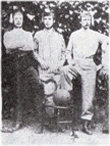 Those with an interest in the history of the game in Victorian times will be pleased to learn that The Wanderers club has been revived with the endorsement of decendants of two of the original founders, the Alcock brothers. The modern club exists to raise funds for charitable causes and in 2011-12 will enter the Surrey South Eastern Combination. Our photo, provided by the modern club, shows an early Wanderers team from the days before uniform kits.
Those with an interest in the history of the game in Victorian times will be pleased to learn that The Wanderers club has been revived with the endorsement of decendants of two of the original founders, the Alcock brothers. The modern club exists to raise funds for charitable causes and in 2011-12 will enter the Surrey South Eastern Combination. Our photo, provided by the modern club, shows an early Wanderers team from the days before uniform kits.
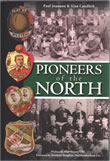 1 April: HFK would like to warmly recommend Pioneers of the North (Paul Joannou & Alan Candlish, Breedon Books 2009) to anyone interested in the history of the game in Victorian times. The book covers the development of the north-east's "big three" (Newcastle United, Sunderland, Middlesbrough), as well as providing a host of detail on the many smaller clubs that sprang up in the region between 1875 and 1890. As a result we have been able to substantially update the Newcastle United section with additional information and kit history for the East and West End clubs.
1 April: HFK would like to warmly recommend Pioneers of the North (Paul Joannou & Alan Candlish, Breedon Books 2009) to anyone interested in the history of the game in Victorian times. The book covers the development of the north-east's "big three" (Newcastle United, Sunderland, Middlesbrough), as well as providing a host of detail on the many smaller clubs that sprang up in the region between 1875 and 1890. As a result we have been able to substantially update the Newcastle United section with additional information and kit history for the East and West End clubs.
In addition we can make the following additions/amendments: Middlesbrough Ironopolis (1889-92 design confirmed): Sunderland (date that red and white shirts were adopted for the first time now confirmed): Berwick Rangers (1881-85, 1885-90 added; 1890-1900 modified): Ashington Rising Star (1883 added).
A number of important and/or interesting North-Eastern club kits have been added to the Eminent Victorians Section and the earliest recorded reference to team colours has been added to Brief History of Football Kits section.
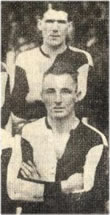 25 March: Featured today is a photograph discovered by Keith Ellis of Wigan Athletic from 1931-32, their first ever season. The team wore red and white halved shirts until competitive football was suspended with the outbreak of the Second World War. Due to shortages, local suppliers could not provide these shirts after the war so the club adopted the blue white we are familiar with today.
25 March: Featured today is a photograph discovered by Keith Ellis of Wigan Athletic from 1931-32, their first ever season. The team wore red and white halved shirts until competitive football was suspended with the outbreak of the Second World War. Due to shortages, local suppliers could not provide these shirts after the war so the club adopted the blue white we are familiar with today.
Torquay United (1901-02 detailing amended).
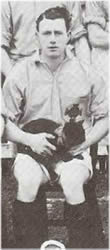 24 March: For some time we have been trying to establish the shade of blue worn by the Irish national side prior to the split between the Irish FA and the FA of Ireland in 1921. Now, thanks to evidence from Jonny Dewart of NIFG I think we can confirm that up until the outbreak of the First World War, the team played in pale blue shirts (probably changing against England and Scotland when playing away from home).
24 March: For some time we have been trying to establish the shade of blue worn by the Irish national side prior to the split between the Irish FA and the FA of Ireland in 1921. Now, thanks to evidence from Jonny Dewart of NIFG I think we can confirm that up until the outbreak of the First World War, the team played in pale blue shirts (probably changing against England and Scotland when playing away from home).
The photograph here shows the team before their drawn match with Scotland in 1914, a result that secured the Home Championship for Ireland for the first time. Note the lucky black cat who is shamefully not identified in the list of players and officials.
The second image is of a jersey worn by Patsy Gallagher 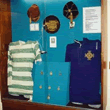 some time after the Great War, which suggests a much darker shade of "St Patrick's blue" was adopted, probably in 1919. This would have meant the team would only have to change every other year when playing Scotland away. HFK believes they then borrowed a set of green tops from the national Irish amateur side.
some time after the Great War, which suggests a much darker shade of "St Patrick's blue" was adopted, probably in 1919. This would have meant the team would only have to change every other year when playing Scotland away. HFK believes they then borrowed a set of green tops from the national Irish amateur side.
Other historical updates: Scotland (strip worn against France in 1958 World Cup added): Bradford Park Avenue (1935-36, 1962-63 added; 1959-60, 1969-70 corrected; the pinstriped green shirt previously shown for 1959-60 now appears in the Iconic Away Kits section): Southampton (2003-04 UEFA Cup strip added).
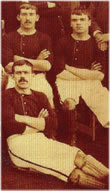 This fine photograph of Hearts from 1889-90, submitted by John Small, reveals some hitherto unrecorded detail including the narrow stripe added to the side seam of the players' knickerbockers. This sort of detailing was not uncommon in the Victorian period but had disappeared completely by the turn of the century, reappearing in the 1930s. Note also the contrast where the inner fly of the collar is visible' which gives us a clue about how these tops were made. Jerseys of this era were usually made from coarse wool, which was hard wearing and warm in cold weather. The inner fly, however, would have been made from another material, probably cotton or linen, making it strong enough for buttons to be sewn on.
This fine photograph of Hearts from 1889-90, submitted by John Small, reveals some hitherto unrecorded detail including the narrow stripe added to the side seam of the players' knickerbockers. This sort of detailing was not uncommon in the Victorian period but had disappeared completely by the turn of the century, reappearing in the 1930s. Note also the contrast where the inner fly of the collar is visible' which gives us a clue about how these tops were made. Jerseys of this era were usually made from coarse wool, which was hard wearing and warm in cold weather. The inner fly, however, would have been made from another material, probably cotton or linen, making it strong enough for buttons to be sewn on.
23 March: Toronto FC (2011 home kit added).
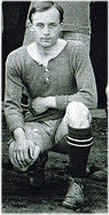 19 March: Featured here is a rare photograph, found by Keith Ellis, of Broxburn United from 1913-14, one of many obscure Scottish sides to have played briefly in the Scottish League between the wars. During the five seasons they played in the competition they attracted a fair amount of controversy, which no doubt contributed to their failure to secure re-election in 1926. (1913-14 added; 1910-12 amended).
19 March: Featured here is a rare photograph, found by Keith Ellis, of Broxburn United from 1913-14, one of many obscure Scottish sides to have played briefly in the Scottish League between the wars. During the five seasons they played in the competition they attracted a fair amount of controversy, which no doubt contributed to their failure to secure re-election in 1926. (1913-14 added; 1910-12 amended).
Montrose (1992-94 amended): Scotland (1914 change kit added): Stirling Albion (1996-98 sleeve detailing added): Wigan Athletic (1973 FA Trophy final kit & crest added): Scunthorpe United (kit worn Sept 2009-May 2010 added): Port Vale (1981-82 added): Hull City (2000-01 corrected): Stockport County (detailing enhanced on various graphics 1979-2000).
What happened when Crewe travelled to Stevenage in September with their away kit? Answer here.
17 March: Major League Soccer gets underway this week in the United States and Canada and our 2011 MLS section is now open.
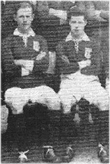 15 March: Thanks to Rumwold Leigh and Jonny Dewart of NIFG, we have discovered a previously unrecorded crest worn by the Irish Free State between 1926, the year of their first official international match, and 1929. The team photograph here was taken in 1927 before the game against an Italian B team, courtesy of NIFG.
15 March: Thanks to Rumwold Leigh and Jonny Dewart of NIFG, we have discovered a previously unrecorded crest worn by the Irish Free State between 1926, the year of their first official international match, and 1929. The team photograph here was taken in 1927 before the game against an Italian B team, courtesy of NIFG.
Wales (1920-21 added; detailing on 1946-47, 1950-51 & 1998 4th kit amended): Scotland (1960-62 corrected - strip previously illustrated now confirmed to be of the Scottish League team).
5 March: John Russell has provided a correction to the item below: Villa in fact wore their pale blue change shirts in the first game against Burnley. Also Ralph Pomeroy has identified Bradford (Park Avenue) splendid striped kit featured on 2 March as their change strip so we have moved it to our Iconic Away Kits 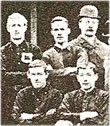 section.
section.
Paul Brown has identified that this photograph from from David Twydell's Football League Grounds For A Change (1991) and featured on 22 January is in fact Newcastle West End and not East End. The new information comes from "Pioneers of the North" (Paul Joannou and Alan Candlish 2009), which also furnishes new information on the colours of Newcastle United's predecessors as well as several non-league teams now added to the Eminent Victorians section.
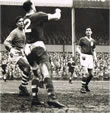 3 March: Until 1989-90 the rules of the FA Cup required both teams to change when colours clashed. This led to problems when change strips also clashed leading to many instances of teams playing in borrowed strips. The two big Birmingham clubs, for example would swap strips when the need arose: the last occasion this happened was, we think, when Aston Villa met Burnley in the sixth round in 1957.
3 March: Until 1989-90 the rules of the FA Cup required both teams to change when colours clashed. This led to problems when change strips also clashed leading to many instances of teams playing in borrowed strips. The two big Birmingham clubs, for example would swap strips when the need arose: the last occasion this happened was, we think, when Aston Villa met Burnley in the sixth round in 1957.
Some time ago regular contributor, Ralph Pomeroy, wrote to HFK about the strips worn in the replay pictured here. Burnley player Jimmy McIlroy wrote:
We wore navy blue shirts and navy blue shorts, and with the referee in his customary all-black outfit it was not surprising that he was given more passes than anyone in our team! .... Fortunately, he changed into a purple shirt at half-time, although I am still not certain whether this simplified or further confused the issue!
Now out of the blue John Russell confirms the details:
At Burnley we played in our usual pale blue change shirts, Burnley played in WHITE shirts, black shorts. When Burnley came to Villa Park for the replay they played in ALL BLACK shirts & shorts. Meanwhile Villa played the game in the RED change shirts borrowed from Birmingham City replete with BADGE. Much was made of this at the time, not least the fact that we then got to play the semi final replay on their ground.
Historical updates: Blackburn Rovers (1941-42 added): Accrington Stanley (1995-96 added).
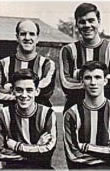 2 March: Scarborough (1976-77 added; 1998-99 socks corrected): Barnsley (1927-28, 1929-30, 1948-49 alternate, 1980-81 alternate added): Rotherham United (1949-50, 1957-58 added): Bradford (PA) 1962-63 added - see photograph left): Hull City (1909-10 shirts now confirmed as striped and not plain black).
2 March: Scarborough (1976-77 added; 1998-99 socks corrected): Barnsley (1927-28, 1929-30, 1948-49 alternate, 1980-81 alternate added): Rotherham United (1949-50, 1957-58 added): Bradford (PA) 1962-63 added - see photograph left): Hull City (1909-10 shirts now confirmed as striped and not plain black).
28 February: Ardwick (1890-91 added): Burslem Port Vale (1892-96 amended): Newton Heath/Manchester United (1892-93, 1893-95 variants added; 1923-24, January 1960 added; notes added concerning variants worn between 1907 and 1915 added to text): Tranmere Rovers (1968-69 added): Macclesfield Town (1987-88 added): Aldershot (Aug-Dec 1989, Jan-May 1990, Feb-March 1991 added).
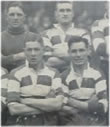 25 February: Cheltenham Town (1951-53, 1953-56, 1959-60, 1965-66x2, 1966-67 added). The photograph is of the Robins team from the early 1930s.
25 February: Cheltenham Town (1951-53, 1953-56, 1959-60, 1965-66x2, 1966-67 added). The photograph is of the Robins team from the early 1930s.
Hereford United (1957-58, 1958-59, 1961-62 added): Yeovil Town (1958-1959 added; 1963-64 amended): Swindon Town (1951-52 added): Peterborough United (1966-67 added): Maidstone United (Invicta emblem added to graphics 1978-92): South Shields (1908-09, 1928-29 added).
Chesterfield (2010-11 third kit added).
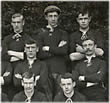 24 February: I have just finished Graham Phythian's very informative Saga of the Silkmen - A History of Macclesfield Town FC (Carnegie 2001) and as a result have been able to give our Macclesfield Town section a very substantial revision adding 20 previously unrecorded kits, a crest history and considerable detail to the tangled history of the club between 1873 and 1948.
24 February: I have just finished Graham Phythian's very informative Saga of the Silkmen - A History of Macclesfield Town FC (Carnegie 2001) and as a result have been able to give our Macclesfield Town section a very substantial revision adding 20 previously unrecorded kits, a crest history and considerable detail to the tangled history of the club between 1873 and 1948.
The photograph is of the 1906-07 team, which was the second incarnation of the club. It is interesting to note that since 2008, the club has been claiming it was formed in 1874 (although the history on the official website is notably vague on the point). Phythian's book tells a rather more complex story, which I have summarised in the club section.
Crest histories have been added to the Newport County, Oldham Athletic, Peterborough United, Plymouth Argyle, Port Vale, Preston North End, Rotherham United and Scarborough sections.
18 February: Crest histories added to Leicester City, Leyton Orient, Lincoln City, Luton Town, Maidstone United, Manchester City, Mansfield Town, Merthyr Town, Millwall.
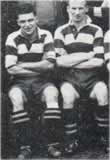 12 February: Aston Villa (strips worn in the FA Cup 1957 and 1953 added): Tottenham Hotspur (kits worn in UEFA Cup 1983-85 added): Halifax Town (kit adopted part way through 1991-92 season added): Brighton & Hove Albion (2010-11 third kit added): Morecambe (1979-80 added): Forfar Athletic (1948-49 added - photo left; 1955-57 cuffs corrected): Liverpool (kit worn against Ajax in December 1966 added).
12 February: Aston Villa (strips worn in the FA Cup 1957 and 1953 added): Tottenham Hotspur (kits worn in UEFA Cup 1983-85 added): Halifax Town (kit adopted part way through 1991-92 season added): Brighton & Hove Albion (2010-11 third kit added): Morecambe (1979-80 added): Forfar Athletic (1948-49 added - photo left; 1955-57 cuffs corrected): Liverpool (kit worn against Ajax in December 1966 added).
Details of the various publications that HFK has provided graphics for are now available in HFK in Print.
8 February: Crewe Alexandra (1974-75, early 1975-76 added; 1908-09, 1909-10 cuffs corrected; various tweaks to modern kit graphics):
2 February: Wolves (1970-72 warm weather strip added): Newcastle United (1967-68 change kit added): Morecambe (2010-11 third added): Bristol City (1986-87 added): Colchester United (1986-87 sponsorship added).
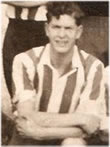 27 January: Shown left is William MacAngus who played for Ross County between 1946 and 1948. The photograph was sent to HFK by William's grandson, Roddy Grey.
27 January: Shown left is William MacAngus who played for Ross County between 1946 and 1948. The photograph was sent to HFK by William's grandson, Roddy Grey.
Aston Villa (1906-07, 1920-21, 1935-36 change kits added): Doncaster Rovers (1942-45, 1974-75 alternate added; various detailing tweaked on other graphics): Gillingham (1986-87 added): Huddersfield Town (1966-67 added).
26 January: Bradford City (1987-88 modified; crest history expanded): Boston United (1997-98 added).
25 January: Stoke City's 1996-97 away kit now features in our Iconic Away Kits section. Brighton (1959-60 alternate kit added).
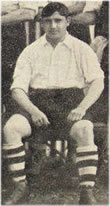 23 January: The burly chap shown here is Mr Ransom, who played for Fulham in the 1903-04 season, their first in the Southern League First Division. The photograph, submitted by Keith Ellis, shows very clearly the hooped socks worn at the time. Although there are examples of hooped "hose" worn in the Victorian period, this is probably the earliest example from the 20th century.
23 January: The burly chap shown here is Mr Ransom, who played for Fulham in the 1903-04 season, their first in the Southern League First Division. The photograph, submitted by Keith Ellis, shows very clearly the hooped socks worn at the time. Although there are examples of hooped "hose" worn in the Victorian period, this is probably the earliest example from the 20th century.
Dundee United (1964-65 added): ES Clydebank (1964-65 badge corrected): St Mirren (1960-61 added; 1961-62 crest amended): Clydebank (1990-91 sponsorship corrected; 1997-98 redrafted): Aberdeen (1911-12 added; 1912-14 collar details refined): Montrose (1995-97 redrafted): Forfar Athletic (1999-2001 crest amended): Dumbarton (2000-02, 2002-04 collar detailing added).
Many HFK regulars share my fondness for early Victorian team photographs and 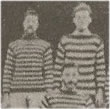 here is another gem from Football League Grounds For A Change (David Twydell 1991). It shows Grimsby Pelham in their first ever season, 1878-79, wearing typical "striped" shirts of the period. Football was strictly amateur at the time and players had to buy their own kit from local suppliers who had different stock, which is probably why some players are wearing jerseys with rather broader stripes.
here is another gem from Football League Grounds For A Change (David Twydell 1991). It shows Grimsby Pelham in their first ever season, 1878-79, wearing typical "striped" shirts of the period. Football was strictly amateur at the time and players had to buy their own kit from local suppliers who had different stock, which is probably why some players are wearing jerseys with rather broader stripes.
 22 January: This image , submitted by Christopher Worrall, comes from David Twydell's Football League Grounds For A Change (1991) and shows Newcastle East End in 1889. After carefully examining the image I've come to the conclusion that the players are wearing halved shirts, most likely in dark red and navy. I have exaggerated the contrast in the thumbnail to bring out this detail. Some players are wearing crests and/or caps, almost certainly awarded for representing the County FA.
22 January: This image , submitted by Christopher Worrall, comes from David Twydell's Football League Grounds For A Change (1991) and shows Newcastle East End in 1889. After carefully examining the image I've come to the conclusion that the players are wearing halved shirts, most likely in dark red and navy. I have exaggerated the contrast in the thumbnail to bring out this detail. Some players are wearing crests and/or caps, almost certainly awarded for representing the County FA.
Peterborough United (1973-74 detailing altered): Brentford (1932-33 added): Fulham (1946-47 added): Leyton Orient (minor changes to detailing on 1934-36, 1936-39, 1950-51): Shrewsbury Town (1952-53 socks corrected): Norwich City (1927-28 added): Southport (1948-52 added).
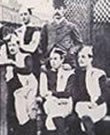 21 January: The value of research into primary sources, such as that of Lionel Bird (see yesterday's entry) is illustrated by Kjell Hanssen's latest find of a cutting from the Blackburn Standard from January 1894, which states that Blackburn Rovers adopted navy and white shirts from their formation in 1874. This contradicts the account given in the Book of Football of 1905. Since both accounts were written 20 and 30 years after the event, it is impossible to verify either without examining contemporary newspaper records, a task that HFK hopes a contributor in the Blackburn area may be tempted to undertake.
21 January: The value of research into primary sources, such as that of Lionel Bird (see yesterday's entry) is illustrated by Kjell Hanssen's latest find of a cutting from the Blackburn Standard from January 1894, which states that Blackburn Rovers adopted navy and white shirts from their formation in 1874. This contradicts the account given in the Book of Football of 1905. Since both accounts were written 20 and 30 years after the event, it is impossible to verify either without examining contemporary newspaper records, a task that HFK hopes a contributor in the Blackburn area may be tempted to undertake.
This interesting photograph from Keith Ellis was presumably taken after 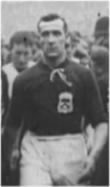 the drawn FA Cup final between Barnsley and Newcastle in 1910 and establishes that the Yorkshire club wore a crest. Note the heavy police escort as the players leave the pitch. Keith has also provided material that expands our Barnsley section (1914-15, 1916-17, 1954-55, 1948-49 added).
the drawn FA Cup final between Barnsley and Newcastle in 1910 and establishes that the Yorkshire club wore a crest. Note the heavy police escort as the players leave the pitch. Keith has also provided material that expands our Barnsley section (1914-15, 1916-17, 1954-55, 1948-49 added).
Scunthorpe United (1983-85 sponsorship added; 1978-79, 1979-82 cuffs corrected): Doncaster Rovers (1932-33, 1996-97, August 1998, 2005-06 minor tweaks to detailing): Brighton & Hove Albion (1917-18 added).
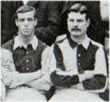 20 January: Our thanks go to Paul Robinson who has forwarded information from the newly published The Teams of Sunderland AFC (Paul Days & Brian Leng 2010) that has allowed us to tidy up our Sunderland records for the late 19th and early 20th century. (1907-08, 1908-09 added; 1904-06, 1906-07, 1909-10 amended and several dates clarified). This intriguing photograph from Days' & Leng's book shows Sunderland lined up with Aston Villa before their match in 1893-94. The players in the thumbnail are both in the Villa team, further evidence that the Villa played in two styles of claret and blue shirts that season and that these
20 January: Our thanks go to Paul Robinson who has forwarded information from the newly published The Teams of Sunderland AFC (Paul Days & Brian Leng 2010) that has allowed us to tidy up our Sunderland records for the late 19th and early 20th century. (1907-08, 1908-09 added; 1904-06, 1906-07, 1909-10 amended and several dates clarified). This intriguing photograph from Days' & Leng's book shows Sunderland lined up with Aston Villa before their match in 1893-94. The players in the thumbnail are both in the Villa team, further evidence that the Villa played in two styles of claret and blue shirts that season and that these 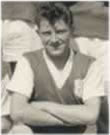 sometimes appeared in the same match. (Click on the image to view the full team photograph.)
sometimes appeared in the same match. (Click on the image to view the full team photograph.)
A short while ago we posted a new graphic of the 1960-61 strip for Queen of the South based on a team photograph that had been sent in. This prompted Bruce Wright to get in touch, questioning if the graphic was correct so we sent him a copy of the original photograph. Bruce was able to identify the team as Collins Boys FC, an amateur side from Dumfries of which he is a member and, by an extraordinary coincidence,Bruce himself appears in the photograph (kneeling far-right and featured in thethumbnail).
Bruce has also supplied a photograph of the Queen of the South team 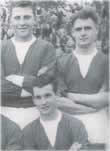 from that season from his collection (left) and our records have now been updated.
from that season from his collection (left) and our records have now been updated.
Lionel Bird, author of The Vocalists (History of Singers FC 1883-1898), has been kind enough to go through his research and provide HFK with details of several previously unrecorded strips worn by Singers FC between 1887 and 1898, when they became Coventry City. (1887-88, October 1889, November 1889, 1891-92 added). Lionel's book is available from the Coventry City Club Shop.
16 January: Brighton & Hove Albion (1904-05 collar modified; additional crest added for 1980): Aldershot (1981-83, 1987-88 added; 1977-81, 1986-87, 1988-89, 1989-91 detailing altered): Middlesbrough (1975-76 shorts detail added; 1987-88, 1988-89 jacquard texture added; crest history added).
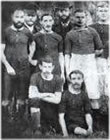 15 January: Pictured here are Small Heath Alliance in 1882 in their amateur days. Note the mixture of white and navy knickerbockers. Players had to provide their own kit at this time and it was quite common for players of small clubs to turn out in various knickers and slightly different designs of shirt.
15 January: Pictured here are Small Heath Alliance in 1882 in their amateur days. Note the mixture of white and navy knickerbockers. Players had to provide their own kit at this time and it was quite common for players of small clubs to turn out in various knickers and slightly different designs of shirt.
Workington (August 1964 added): Southampton (sock detailing added to graphics 1903~1924): Chesterfield (1930-31 added): Bristol City (1956-57 alternate strip added): QPR (1938-39 socks corrected): Wales (1949 change graphic now has accurate crest; 1931-39, 1947-50 cuffs corrected): Rushden & Diamonds (2000-02, 2004-05 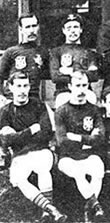 detailing amended): Fulham (1908-14 added): Notts County (1936-37 added; 1956-59 amended): Barnsley 1920-21 added): Burnley (1966-67 detailing amended): Macclesfield Town (1969-70 corrected).
detailing amended): Fulham (1908-14 added): Notts County (1936-37 added; 1956-59 amended): Barnsley 1920-21 added): Burnley (1966-67 detailing amended): Macclesfield Town (1969-70 corrected).
Back in December 2009 we featured this photograph of Dumbarton FC taken in 1883 when they won the Scottish Cup. Jim Jenkinson established that the various badges included those awarded to players who represented the Scottish Counties in a series of matches against select teams from the Glasgow, Lancashire and Birmingham FAs. Regular HFK visitors will know that it was common practice for players who won representative honours to have the crests awarded on those occasions sewn onto their club jerseys at this time
We can now update this story with this photograph of the ScottishCounties XI discovered by Chris Whitefield. If you compare the two images you can see that 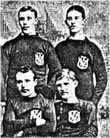 several of the Dumbarton players are sporting the Scottish Counties crest on their tops.
several of the Dumbarton players are sporting the Scottish Counties crest on their tops.
Kjell Hanssen has discovered an interesting set of Victorian postcards from 1894 that feature the colours of leading English and Scottish clubs. Although these images are not particularly accurate, they do suggest that Historical Football Kits had a Victorian predecessor. You can view the complete set on the National Archive Website.
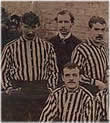 9 January: Third Lanark (1921-23 collar amended): Rangers (1992-94 cuffs amended): Falkirk (1968-70 collar and cuffs corrected): Alloa (1920-27 collar corrected): St Mirren (1965-66 added; 1884-1898 detailing added - see photo left): Brechin City (1988-90 corrected): Gretna (2006-07 sock detailing added): Greenock Morton (1921-22 added): Dundee Hibernian (1913-15 cuffs altered): Raith Rovers (1962-63 warm weather/Scottish Cup final kit added): Queen of the South (1960-61 added): Dumbarton (1991-93 sponsor's logo redrawn): Arbroath (1959-60 warm weather kit added).
9 January: Third Lanark (1921-23 collar amended): Rangers (1992-94 cuffs amended): Falkirk (1968-70 collar and cuffs corrected): Alloa (1920-27 collar corrected): St Mirren (1965-66 added; 1884-1898 detailing added - see photo left): Brechin City (1988-90 corrected): Gretna (2006-07 sock detailing added): Greenock Morton (1921-22 added): Dundee Hibernian (1913-15 cuffs altered): Raith Rovers (1962-63 warm weather/Scottish Cup final kit added): Queen of the South (1960-61 added): Dumbarton (1991-93 sponsor's logo redrawn): Arbroath (1959-60 warm weather kit added).
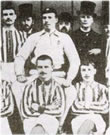 3 January: Photographs of West Bromwich Albion's FA Cup winning team from 1888 show one of the players wearing a plain white shirt. This was long before goalkeepers were required to wear distinctive tops, prompting Rumwold Leigh to look into the matter further. The player in the white top is indeed the Albion goalkeeper, Bob Roberts, and he is in fact wearing an England shirt (you can just make out the three lions crest) as well as his England cap. The practice of sewing national or county crests onto club shirts had more or less died out out by 1888 so it appears that Roberts decided to broadcast his international credentials by posing in his England shirt. It is unclear if he wore it during the
3 January: Photographs of West Bromwich Albion's FA Cup winning team from 1888 show one of the players wearing a plain white shirt. This was long before goalkeepers were required to wear distinctive tops, prompting Rumwold Leigh to look into the matter further. The player in the white top is indeed the Albion goalkeeper, Bob Roberts, and he is in fact wearing an England shirt (you can just make out the three lions crest) as well as his England cap. The practice of sewing national or county crests onto club shirts had more or less died out out by 1888 so it appears that Roberts decided to broadcast his international credentials by posing in his England shirt. It is unclear if he wore it during the 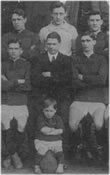 match itself.
match itself.
The rest of today's material comes from Keith Ellis and includes several unrecorded strips for South Shields (1905-06, 1910-12, 1912-13, 1923-24 added). The photograph shows the team in 1912-13 wearing red shirts with a green yoke.
Berwick Rangers (1912-13 added): Chelsea (1961-62 alternate home kit added): Swansea Town (1962-63 added): Port Vale (1900-01, 1984-85 added; 1896, 1912-13 altered): Nottingham Forest (circa 1928 added).
Our next photograph is of Derby County and is dated 1889-90. The point of interest is that the team is dressed in white shirts with a large coloured pocket,which I have assumed was cardinal red as this was the most commonly used colour 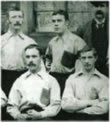 that featured in the team's shirts at around this time.
that featured in the team's shirts at around this time.
Leicester City (1960-61 added): Oxford United (1949-50 corrected: additional sponsor logo added to 1984-85 graphic).
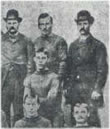 2 January: According to the club's official historian, Norrie Price, Dundee FC alternated between the striped shirts of East End and the plain navy of Our Boys in the 1893-94 season. The two had merged to form the modern club in 1893. This rather grainy photograph is of Our Boys taken in 1880. I'm grateful to Donald Gellatly for this nugget.
2 January: According to the club's official historian, Norrie Price, Dundee FC alternated between the striped shirts of East End and the plain navy of Our Boys in the 1893-94 season. The two had merged to form the modern club in 1893. This rather grainy photograph is of Our Boys taken in 1880. I'm grateful to Donald Gellatly for this nugget.
Barnsley (1962-63 added, 1994-95 sponsorship corrected): York City (1956-57 added): Stockport County (1954-55 added; 1971-72 corrected): Queen's Park (1994-95 added): Brechin City (1995-99 graphics modified).
Previous Updates: 2015 | 2014 | 2013 | 2012 | 2011 | 2010 | 2009 | 2008 | 2007 | 2006